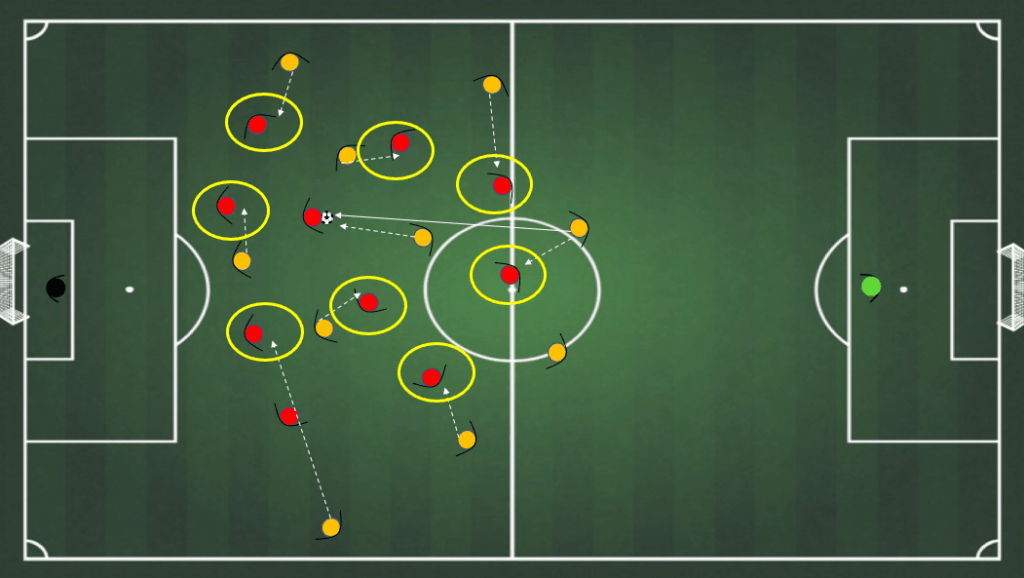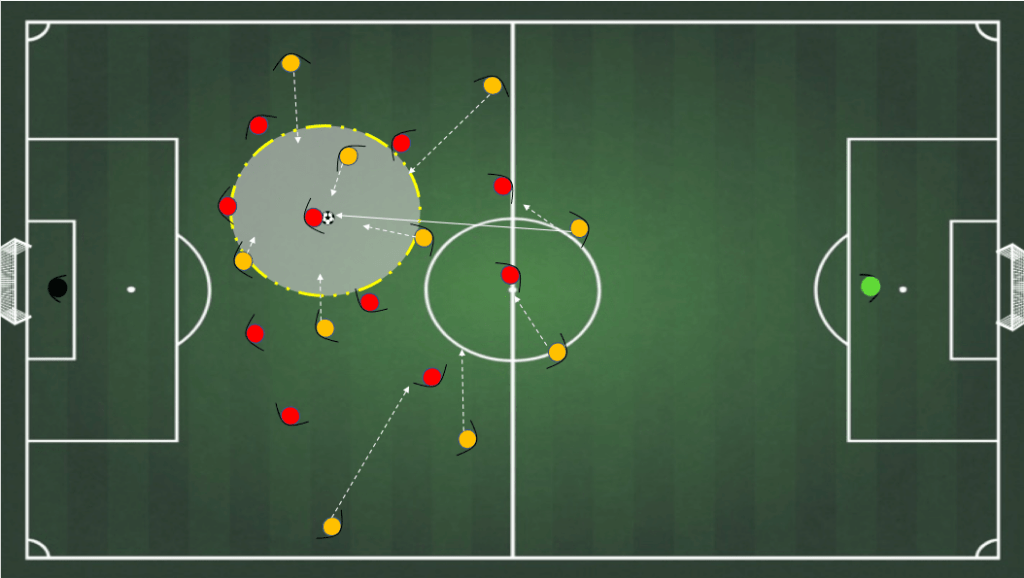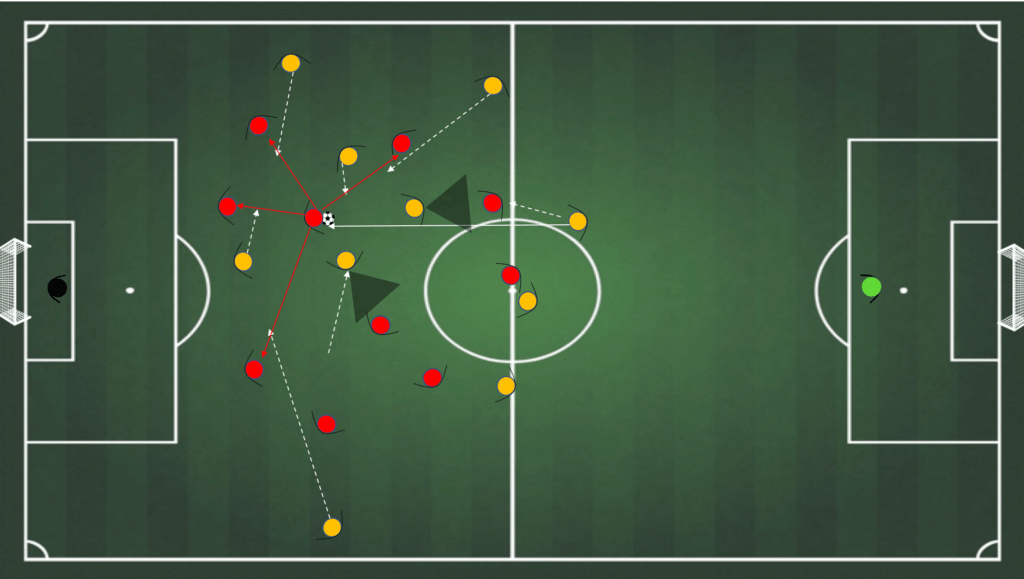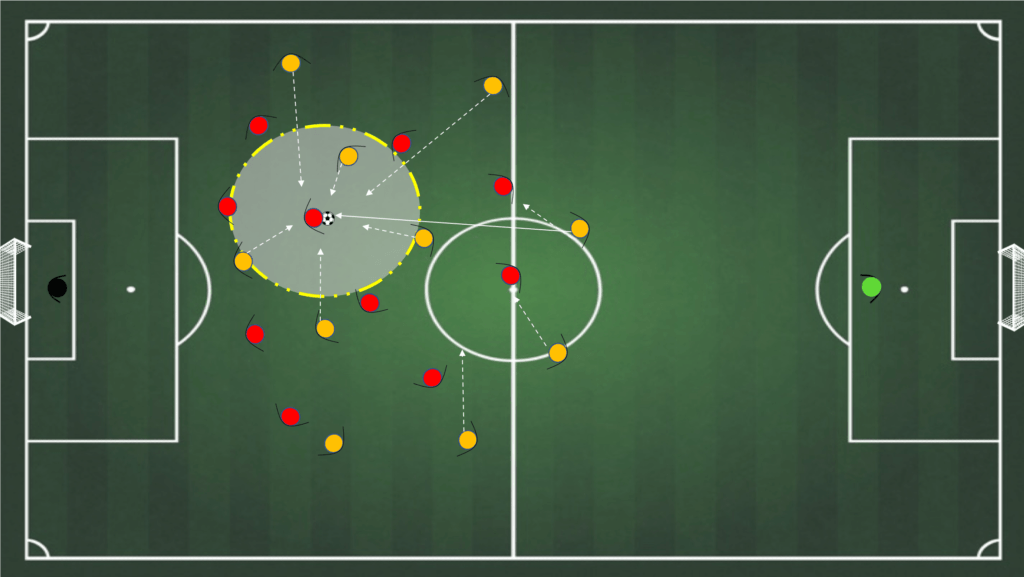Table of Contents
The transition to a defense approach known as Gegenpressing has received considerable recognition in modern football because of its successful implementation by coaches like Jurgen Klopp, Pep Guardiola, and Marcelo Bielsa. This aggressive and energetic approach to the game has resulted in numerous victories and accolades for teams such as Liverpool, Borussia Dortmund, and Bielsa’s National Team of Chile in the Premier League. Dotrmund’s football under Klopp was characterized as “heavy metal football” for its high intensive tempo.
In this piece, we will explore the concept of Gegenpressing, the strategic aspects associated with it, the tactics behind and it’s potential to lead to scoring goals and successful outcomes.
Introduction
Gegenpressing, also known as counter-pressing, is a defensive tactic employed by teams immediately after losing possession. The primary objective of Gegenpressing is to win back the ball as quickly as possible by putting pressure on the opposition. This high-intensity style of play requires players to work together as a unit, hunting the ball and preventing the opponent’s counterattack. The ultimate goal is to regain the ball, disrupt the opposition’s rhythm, and create scoring opportunities.
The Origins of Gegenpressing
The origins of Gegenpressing can be attributed to the philosophies of renowned football mentors Rinus Michels and the great football manager Johan Cruyff. These visionary Dutch coaches advocated for an aggressive style of play that prioritized swiftly regaining the ball. Nonetheless, contemporary football has witnessed a revival of pressing games due to the influence of Klopp and Marcelo Bielsa, who have elevated this strategy to unprecedented levels.

The German coach has popularized Gegenpressing with his “Intensity Football” philosophy at Liverpool, leading them to Premier League and UEFA Champions League success.
Bielsa, on the other hand, has implemented this philosophy with his own unique twist, transforming teams like Athletic Bilbao and Leeds United.
Do you want to train your team like Jurgen Klopp? Check the latest Soccer Tutor’s book.

102 Passing, Counter-pressing Possession Games, Speed & Warm-ups Direct from Klopp’s Training Sessions – Vol. 1
- Learn, and apply Jürgen Klopp’s exact training methods direct from his Liverpool training sessions, so your team can reproduce his highly successful all-action pressing and attacking style of play.
- Full Liverpool Pre-Match Warm-up
- 8 Pre-season Training Practices
- 13 Warm-up Exercises (With and Without a Ball)
- 17 Speed & Agility Exercises
- 41 Passing Combinations
- 22 Pressing and Counter-pressing Rondos and Possession Games
- The 102 Practices included in this book are all taken directly from Klopp’s training sessions with Liverpool F.C. between 2017 and 2022.
Tactical Aspects
To successfully implement this strategy, the entire team must focus on several key tactical aspects. These include positioning, pressing triggers, and decision-making.
Positioning
For effective counter-pressing, players must maintain close proximity to one another, allowing them to press as a cohesive unit immediately after losing possession. Klopp was fortunate in Liverpool to have some very intelligent players like Sadio Mane, Roberto Firmino, and Mohamed Salah who excel in positional awareness. This s also one of the positional play fundamentals. This requires a balance between staying close enough to support teammates and covering enough space to prevent easy passes for the opposition. A well-organized team shape is essential to successful Gegenpressing.
Midfielders are crucial payers due to their position on the pitch. They are usually the first players who can press the ball.
Pressing Triggers
Pressing triggers are specific cues that signal when a team should initiate pressing. These can include:
- An opponent receiving a pass with their back to goal
- A loose or misplaced pass by the opposition
- The ball going out wide to a less dangerous area on the field
- A backward pass towards the opponents goal
Teams must be well-drilled in recognizing these pressing triggers and reacting quickly when there is good gegenpressing situation.
Decision-Making
An essential aspect of Gegenpressing is knowing when to stop pressing and retreat into a defensive shape. Teams typically employ a “five-second rule,” where they press with maximum intensity for five seconds after losing possession. If the ball is not won back within this time frame, the team should transition back into their defensive formation.
Four variants of Gegenpressing
Gegenpressing can be implemented in various ways, depending on the desired approach and the specific circumstances of a match. Here are four primary variants of Gegenpressing:
1. Man-Oriented
In this approach, players immediately mark an opponent after losing possession. The goal is to cut off passing options and force the opposition into making mistakes.
It involves a relentless and coordinated effort by the pressing team to mark and apply pressure on the opposing players individually. Rather than focusing on specific zones or areas of the field, man-oriented pressing emphasizes the close tracking and engagement of opponents, especially whoever s considered a possible passing receiver, regardless of their position on the pitch.
In this approach, as soon as the team loses possession, each player quickly identifies and selects an opponent to mark closely. By closing the nearby opponents, the pressing players aim to cut off passing options and force the opposition into making mistakes under intense duress.
Man-oriented pressing demands a high level of coordination, communication, and individual discipline from the pressing team. The players must be aware of their defensive responsibilities and react promptly to transitions in possession.

2. Leeway-Oriented
In Leeway-Oriented Gegenpressing, players are not solely focused on sticking tightly to their marked opponents. The team is primarily focused on the ball carrier and the surrounding area, thus, this variant aims to generate maximum pressure on the opposition.
While still prioritizing the disruption of passing options and forcing mistakes, this approach recognizes the importance of adapting based on the situation on the pitch and having a balance between aggressive pressing and maintaining defensive solidity. It acknowledges that overcommitting to pressing all opponents can leave gaps in the defensive structure, which can be exploited through passes behind the pressing lines or the back line.
This approach requires a high level of tactical intelligence, teamwork, and coordination among the players to ensure that they collectively maintain defensive stability while also actively engaging in pressing actions.

3. Passing Lane-Oriented
Unlike the conventional approach of pressuring the ball carrier, this variation places a strong emphasis on intercepting passes as a means of regaining possession. Players adeptly position themselves strategically between opponents, aiming to disrupt passing lanes and capitalize on opportunities to recover the ball after a pass is made.
Under Guardiola’s leadership, FC Barcelona, Bayern Munich and Manchester City mastered the art of Passing Lane-Oriented Gegenpressing, showcasing their exceptional ability to read the game and anticipate opponents’ passing intentions.
By positioning themselves effectively, the Guardiola’s players not only limited the available passing options for their adversaries but also created an environment conducive to intercepting those passes. Using this tactic they have managed to conquer La Liga, German Football, and English Premier League.
This style of play required a high level of spatial awareness, quick decision-making, and coordinated movements, as the players worked in unison to exploit the passing lanes and seize possession.

4. Ball-Oriented
Ball-Oriented Gegenpressing is a variation of the Gegenpressing strategy that focuses primarily on aggressive ball pursuit, disregarding the maintenance of a compact team structure. In this approach, players exhibit a relentless determination to move toward the ball, regardless of their positional responsibilities.
This style bears similarities to the “lee-way” concept, but with the key distinction that the surrounding area is of little importance; only the ball itself takes precedence. The essence of Ball-Oriented Gegenpressing lies in creating high-pressure situations for the opponent by swarming the ball carrier with multiple players.
However, while Ball-Oriented Gegenpressing can be highly effective when executed correctly, it also carries risks. The emphasis on individual player reactions and prioritizing the ball over maintaining positional structure can leave the team vulnerable to counterattacks if not coordinated well.
Nonetheless, this aggressive style has been employed in the past, most notably by the 1970s Ajax and Netherlands national teams.

Why Gegenpressing is Important
Gegenpressing is widely recognised and esteemed as a practice utilized frequently and successfully during defensive shifts. This strategy is chosen due to a variety of factors, including the high attacking potential it provides, the team’s rigorous planning, and the strong defensive unity it develops.
- Defensive Stability
Teams must be able to defend effectively against counterattacks due to the fast-paced nature of modern football and the emphasis on quick transitions. By counterpressing, teams can break the rhythm of their opponents, start transitioning to attack situations, and retain defensive stability.
- Maintaining Organization
Teams can prevent losing organization and space on the field by regaining possession quickly by Gegenpressing. They can keep their offensive structure and take advantage of scoring opportunities as a result.
- Improved Attack
Gegenpressing can lead to scoring goals by winning the ball in high areas and exploiting the opposition’s defensive vulnerabilities.
Gegenpressing is the best playmaker in the world
Jurgen Klopp
How to train Gegenpressing
Positional games and rondos, which are small-sided drills in which one team tries to maintain the ball while the other team tries to recover it, are two ways to practice this approach.
Rondos aid in the improvement of a player’s pressing game, movement, spatial awareness, decision-making, and press-and-counter-press abilities. Coaches can construct numerous scenarios that mimic the occurrences in a real match by adjusting the number of players, the size of the area, and the amount of touches permitted.
Other coaches using Gegenpressing
Jesse Marsh, the former assistant of Ralf Rangnick, the mastermind behind RB Leipzig’s success in the Bundesliga shares his insights on how to implement the high-intensity pressing style. Rangnick brought to Old Trafford and Manchester United this high intensive pressing style. He also gives practical tips on how to train your players, set up your tactics, and adapt to different opponents. Gegenpressing is not just a buzzword, it’s a philosophy that can transform your team into a winning machine.
Conclusion
The main benefit of Gegenpressing is that it compels the opposition to make errors. Teams can take advantage of the weak spots as the opposition switches from defense to attack by putting pressure right away after losing possession. Gegenpressing’s aggressive, quick-moving style and aptitude for taking the “first step” in exerting pressure are the secret to its effectiveness.
In conclusion, the success of teams like Klopp’s Liverpool and Bielsa’s Leeds United shows that gegenpressing has become a crucial approach in contemporary football. Aspiring coaches and players can improve their skills and have more success on the field by comprehending the subtleties and tactical elements of Gegenpressing. Teams can sabotage the opposition, preserve defensive stability, and generate goal-scoring opportunities by becoming experts at counter-pressing.

